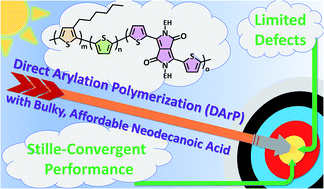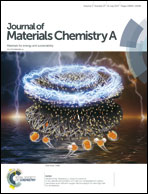Evaluating structure–function relationships toward three-component conjugated polymers via direct arylation polymerization (DArP) for Stille-convergent solar cell performance†
Abstract
The utilization of direct arylation polymerization (DArP) for the tin-free synthesis of three-component semi-random copolymers is rare, as several assumptions derived from Stille polycondensation—such as functional group assignment, monomer reactivity, defect tendencies, and practical performance—are not necessarily applicable across a broad range of DArP conditions and monomer substrates. Through a comparative analysis of conditions on increasingly complex model systems ranging from P3HT (where highly successful but distinct conditions are compared for the first time herein) to a three-component polymer architecture featuring ubiquitous diketopyrrolopyrrole (DPP), reaction conditions are optimized to generate polymers that perform similarly to Stille reference polymers in solar cells. Subsequently, these optimized conditions are then applied to the synthesis of several novel semi-random polymers, exploring a variety of both electron-poor and electron-rich substrates, such as (E)-2-(2-(thiophen-2-yl)vinyl)thiophene (TvT), 4,4′-dimethyl-2,2′-bithiazole (BTz), and 3,4-ethylenedioxythiophene (EDOT) as well as distinct acceptor units, such as pentacyclic aromatic lactam, 4,10-bis(2-ethylhexyl)thieno[2′,3′:5,6]pyrido[3,4-g]thieno[3,2-c]isoquinoline-5,11(4H,10H)-dione (TPTI) and 2,3-bis(3-(octyloxy)phenyl)quinoxaline (QX), further demonstrating the broad compatibility of these DArP conditions and expanding the semi-random toolkit toward achieving polymers with a variety of highly tunable optoelectronic properties. Polymers are characterized by NMR analysis, electrochemical HOMO level determination, UV-Vis, GIXRD, DSC, SCLC hole mobilities, and are also implemented into polymer solar cells.



 Please wait while we load your content...
Please wait while we load your content...